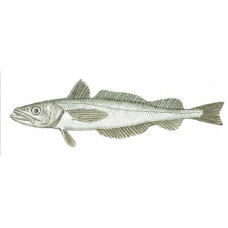Latin name
Merluccius productus
Other names
Haddock, butterfish, California hake, popeye, silver hake, ocean whitefish; French: merlu du Pacifique nord; Spanish: merluza del Pacífico norte.
Identification
The body of the Pacific hake is elongated, slender, and moderately compressed. The head is elongated, and the mouth is large, with strong, sharp teeth. The thin scales fall off easily. Coloration is gray to dusky brown, with copper shades and black speckles on the back. The elongated shape, serrated second dorsal and anal fin, and coloration distinguish the Pacific hake from other fish in this family.
Distribution
Occurs in the Gulf of California and from Magdalena Bay, Baja California, to Alaska. Several populations are distinguished: oceanic, fjord (in inland waters of British Columbia), red dwarf (off the California Peninsula), etc.
Habitat
A benthic-pelagic species. It prefers deep sandy areas and has been found at depths of more than 2,900 feet. Usually found from the surf zone to a depth of 1,000 m. Comes into desalinated pre-mouth areas and estuaries. Occurs at water temperatures of 6-17 °C, and juveniles prefer higher temperatures (more than 10 °C).
Size
Pacific hake can grow up to 3 feet in length. The record weight in tackle is 2 pounds 2 ounces. But usually fish less than 60 cm in length. Lives at least 16 years (this was the age of an individual 83 cm long). Grows fairly quickly. Matures at a length of 35-42 cm in 3-4 years.
Life history and Behavior
Spawning occurs in winter or from February to April, beginning at age 3-4, off the coast of Southern California and Baja California, Mexico. After spawning, the adults migrate north to Oregon, Washington, and Canada before returning to their spawning grounds in the fall. This species is classified as demersal, but is mostly pelagic in oceanic and coastal areas. Adults congregate in large schools in waters above the continental shelf, except during the spawning season, when they move several hundred miles out to sea.
Food and feeding habits
The Pacific hake feeds on euphausiids, decapods, a variety of small fish, shrimp, and squid.
Reproduction
Spawning occurs at depths away from shore (up to 30-80 miles), off Southern California and in the Gulf of California. Spawning takes place in portions, lasting from January to June (peak in February-March). Fertility is 46,000 to 500,000 eggs. Eggs are pelagic. It develops in the water level between 60-200 m at a temperature of 8.6-15.7°С. Its incubation period lasts from 2 to 14 days; at 13-14 °C, it lasts 3 to 3.5 days.
| Classification | |
| Phylum | Chordata |
| Class | Actinopterygii |
| Squad | Gadiformes |
| Family | Merlucciidae |
| Genus | Merluccius |
| Species | М. productus |
| Features | |
| Conservation status | Least Concern |
| Habitat | Pelagic |
| Life span, years | 20 |
| Maximum body weight, kg | 1.2 |
| Maximum length, cm | 91 |
| Sailing speed, m/s | No information |
| Threat to people | Edible |
| Way of eating | predator |


